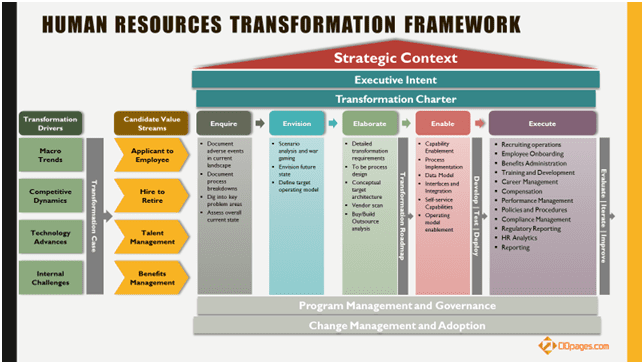Human Resources Transformation Framework
By: Ciopages Staff Writer
Updated on: Feb 25, 2023

CIOPages.com Human Resources Transformation Framework is a simple and cohesive approach to conceptualizing, planning and executing a core shift in how Human Resources function shall operate in the future.
Before we delve into the components of the Human Resources Transformation Framework briefly, please also note that CIOPages.com offers a several HR Transformation Resources, including a Human Resources Transformation Toolkit.
Transforming Human Resources functions are often an in-depth and invasive exercise, particularly as it impacts one of the most important resources of a company – its people. Furthermore, the scope and the extent of transformation – operating model, processes, systems – could exponentially increase the complexity and cost. Hence, leveraging an integrated HR transformation framework will help lessen the risk and improve the odds of success.
CIOPages.com Human Resources Transformation Framework Components:
Strategic Context:
CIOPages.com Human Resources Transformation Framework starts with understanding the strategic context of the proposed transformation. The task will involve getting your arms around the business needs, the corporate objectives, the future vision of the company, and the impact and implications for people, which in turn influences the nature and extent of human resources transformation.
Executive Intent:
Executive Intent details the people goals, objectives and desired outcomes as well as the level of support for the Human Resources transformation endeavor. It will be essential to create a stakeholder map to capture the degree of interest, influence, and intent of various stakeholders on the proposed HR transformation.
Transformation Charter:
The HR transformation charter is a concise and cogent summary of what problems the firm is trying to solve for and the desired outcomes from the change endeavor, including solution approaches. It is not a detailed business case or a project charter, but a higher-level document.
Transformation Drivers:
The next component of the Human Resources transformation framework is identifying and documenting the external and internal factors that are necessitating the change. These HR transformation drivers are as follows:
- Macro trends: These are global and national events shaping the economy, industry, and the society as a whole, which in turn will impact the company. These can range from demographics to social mores, globalization to environmental considerations, from geopolitical events to labor movement. A PESTLE (Political, Economic, Social, Technological, Legislative and Ecological) analysis is a good way to capture the shifts.
- Competitive Dynamics: These factors are typical competitive analysis and should include not only the direct competitors, but indirect competitors, emerging non-traditional competitors who may upend the industry, and others. A competitive analysis framework such as Michael Porter’s Five Forces Model might be useful.
- Technology Advances: Thack Brown of SAP listed five technology factors which are influencing Human Resources functions. Also, there may be others which may be impacting the Human Resources value streams in your particular industry.
- Internal Challenges: The key challenges are all the current state problems that the firm is facing in the Human Resources operations. These items comprise of all the breakdowns, service recovery incidents, process bottlenecks, data inaccuracies, delays, cumbersome processes.
Candidate Value Streams:
The candidate value streams address the scope and enormity of the transformation challenge by identifying end-to-end Human Resources value streams of the company. It depends on the extent of the transformation your firm is undertaking, but typically the value streams could be Applicant to Employee, Hire to Retire; Compensation and Benefits; and Talent Management.
Transformation Steps:
CIOPages.com Human Resources Transformation Framework outlines six steps in implementing a Human Resources transformation program.
- Enquire – Understand the current state issues, challenges, and impediments.
- Envision – Paint a picture of the future without being encumbered by the current situation.
- Elaborate – Drill down into the details, and establish how to get it done in greater detail.
- Enable –This is where the rubber hits the road as in actually implementing the changes envisaged in the transformation.
- Execute – This step involves operating the new generation Human Resources processes and operations included in and re-engineered as a part of the Human Resources transformation framework.
- Evaluate – This addresses the concept of measuring the key success factors and key performance indicators and using that learning to improve the Human Resources function iteratively and incrementally in the aftermath of the HR transformation.
Program Management:
Needless to add no Human Resources transformation framework is complete without program management and governance. The scope includes the project funding, the setting up of steering committees, the governance structure, the PMO office, as well as projects and work streams. Should you need it, CIOPages.com offers a Human Resources Transformation Project Plan list.
Change Management and Adoption:
A Change Management Plan is a critical consideration in any transformation endeavor. Hence including a robust change management plan will be extremely vital in making any major transformation program a success.
You can download the CIOPages.com Human Resources Transformation Framework PowerPoint for free (after social sharing). And of course, you modify the PowerPoint for your needs, as long as it contains the citation “Adapted from CIOPages.com Human Resources Transformation Framework”.
You may also find the following frameworks useful: Novius and BCG.